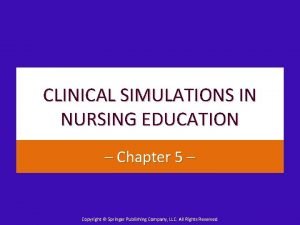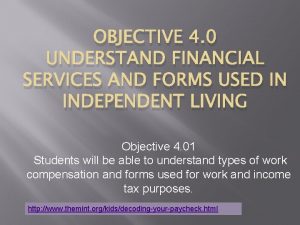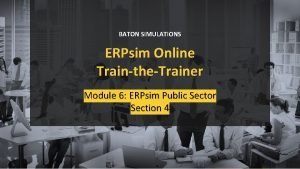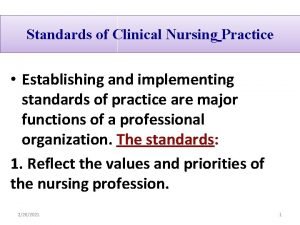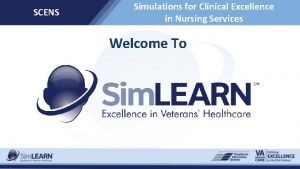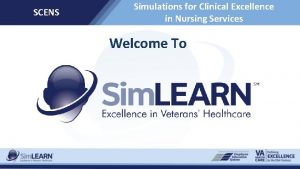CLINICAL SIMULATIONS IN NURSING EDUCATION Chapter 5 Copyright












- Slides: 12

CLINICAL SIMULATIONS IN NURSING EDUCATION – Chapter 5 – Copyright © Springer Publishing Company, LLC. All Rights Reserved.

Roles of Simulation § Traditionally, simulations are used to provide opportunities for students to practice patient care in a safe environment § In the current environment of increasing patient acuity and limited clinical placements, simulation has a broader role as an adjunct or replacement for traditional clinical hours § Institute of Medicine cited simulation as critical for producing an adequate number of competent nurses Copyright © Springer Publishing Company, LLC. All Rights Reserved. 2

Different Types of Simulations § Vary in degree of fidelity or ability of the simulation environment to best replicate the actual clinical environment § Fidelity is realism § Allows learner to become engaged within the simulation – On physical, conceptual, emotional, and experiential levels Copyright © Springer Publishing Company, LLC. All Rights Reserved. 3

Manikin-Based Simulation § Manikins as human patient simulators (HPS) vary in amount and degree of technology and fidelity – Fidelity reflects the level of engagement expected of participants in simulation – High, medium, and low fidelity Copyright © Springer Publishing Company, LLC. All Rights Reserved. 4

Manikin-Based Simulation (cont) § Decision about level of fidelity is determined by – What is available – Objectives of experience – Intended learner outcomes § Moulage: use of makeup, dress, and wigs to enhance the patient story and simulation enhancers to simulate injury, disease, aging, and other physical enhancements Copyright © Springer Publishing Company, LLC. All Rights Reserved. 5

Standardized Patient § Individual who is trained to portray patient with specific condition and plays that patient consistently during every simulation – Within simulation, can portray patients but may also function as either teacher or evaluator – Often used to teach and evaluate physical examination and communication Copyright © Springer Publishing Company, LLC. All Rights Reserved. 6

Virtual Simulation § Learners access internet-based, 3 -dimensional simulated environments for an educational experience § Gaming can be incorporated within simulation § Simulation learning objectives should dictate type of simulation Copyright © Springer Publishing Company, LLC. All Rights Reserved. 7

Integration Into Curriculum § Simulations should be leveled throughout curriculum, building in complexity and ambiguity – Use of an unfolding case • Students introduced to particular patient repeatedly at different points in care continuum within a simulation, throughout a course, or throughout the curriculum – Repeat same case but use a modified version § Steps – Creation or selection of simulation scenario – Planning and implementing simulation in a course Copyright © Springer Publishing Company, LLC. All Rights Reserved. 8

Debriefing § During debriefing, teachers guide students to reflect on, analyze, and discuss their thoughts and feelings about the experience § Is a constructivist, reflective teaching strategy – Provide feedback § Debriefing methods – Plus Delta, Debriefing for Meaningful Learning, Advocacy-Inquiry, and Gather-Analyze-Summarize Copyright © Springer Publishing Company, LLC. All Rights Reserved. 9

Simulation Evaluation § Identify purpose and focus of the evaluation § Select or develop appropriate evaluation instrument § Select and train raters to complete the evaluation – Essential to ensure valid and reliable results § Kirkpatrick levels of outcomes can be used for categorizing evaluation strategies Copyright © Springer Publishing Company, LLC. All Rights Reserved. 10

Participant Performance Evaluation § Simulation offers opportunities for evaluation of learner performance § Create and standardize scenarios to evaluate specific skills and behaviors § Allow multiple participants to engage in given scenario or an individual participant to engage in specific scenario multiple times § Allow participant to make errors without endangering a patient Copyright © Springer Publishing Company, LLC. All Rights Reserved. 11

Research on Simulation § Simulation has been shown to be an effective educational method § Deliberate practice used to assist learner to master clinical skill or behavior – Simulation should incorporate deliberate practice – Nine elements § Areas needing research – Lack of valid and reliable evaluation instruments to measure simulation outcomes – Types of simulation scenarios to use for measuring outcomes Copyright © Springer Publishing Company, LLC. All Rights Reserved. 12
 Clinical simulations in nursing education
Clinical simulations in nursing education Don't gamble with physical properties for simulations
Don't gamble with physical properties for simulations Chris harding simulations
Chris harding simulations Tcad simulations
Tcad simulations World history simulations
World history simulations Simulations for solid state physics
Simulations for solid state physics Www.irs.gov/app/understanding taxes/student/simulations.jsp
Www.irs.gov/app/understanding taxes/student/simulations.jsp Key tenets of ippd
Key tenets of ippd Baton simulations
Baton simulations Nursing clinical ladder examples
Nursing clinical ladder examples Clinicalkey for nurses
Clinicalkey for nurses Standards of clinical nursing practice
Standards of clinical nursing practice Translating research findings to clinical nursing practice
Translating research findings to clinical nursing practice
